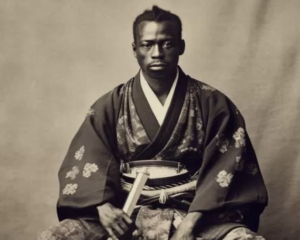In 1581, Yasuke captured the interest of Oda Nobunaga, a powerful warlord striving to unify Japan as it emerged from the chaos of the Sengoku period.
1581年,彌助引起了織田信長的興趣,織田信長是一位強大的軍閥,致力于從戰國時期的混亂中統一日本。
This era, also known as the "Age of Warring States," was among the most turbulent in Japanese history, with constant military conflict as warlords battled for control over fractured territories.
這一時期,也被稱為“戰國時代”,是日本歷史上最動蕩的時期之一,軍閥們為了控制分裂的領土而不斷發生軍事沖突。
During this time, Japan also experienced its first major encounters with foreign cultures, as Portuguese and Spanish traders and missionaries began arriving in the 1540s.
在此期間,隨著葡萄牙和西班牙的商人、傳教士在16世紀40年代開始抵達日本,日本也經歷了與外國文化的第一次重大接觸。
Upon their meeting, Nobunaga famously scrutinized Yasuke's skin, initially believing it to be painted black.
在二人見面時,信長仔細檢查了彌助的皮膚,一開始他認為彌助的皮膚是被涂成黑色的。
Convinced this was the case, Nobunaga ordered him to bathe.
對此很確定的信長,隨后命令彌助去洗澡。
Despite this unusual introduction, Yasuke quickly impressed Nobunaga, having already picked up some Japanese.
盡管這種介紹方式不同尋常,但已經學會了一些日語的彌助很快給信長留下了深刻的印象。
Nobunaga soon transferred him from Jesuit service into his own, honoring him with a house, money, servants, and even the new name, Yasuke.
信長很快將彌助從耶穌會調到自己麾下,賜予他房子、金錢、仆人,甚至他起了一個新名字,“彌助”。
According to Jesuit chronicler Luís Fróis, many assumed Nobunaga would continue to lavish honors on Yasuke and elevate him to a lord.
根據耶穌會編年史家路易斯·弗洛伊斯的說法,許多人相信信長繼續給予了彌助榮譽,并提升他為領主。

Historians debate whether Yasuke was technically a samurai, a term that denoted more than just a warrior.
歷史學家對彌助是否嚴格意義上是一名武士爭論不休,“武士”這個術語不僅僅指一名戰士。
Samurai were generally born into this class and underwent rigorous training from a young age, learning not only combat skills but also the cultural and philosophical tenets of the role.
武士通常出身于這個階層,從年輕時起就接受嚴格的訓練,不僅要學習戰斗技巧,還要學習這個角色的文化和哲學原則。
But given the honors lavished on him and that Nobunaga presented him with a sword, it's probable that he may have been considered an honorary one.
但考慮到彌助所獲得的榮譽以及織田信長贈予了他一把劍,他很可能被視為榮譽武士。
Samurai or not, Yasuke proved his loyalty, fighting alongside Nobunaga in his campaigns to consolidate power across Japan.
無論是否是武士,彌助證明了他的忠誠,在與信長一起進行的統一日本權力的戰役中并肩作戰。
In 1582, one of Nobunaga's vassals, Akechi Mitsuhide, launched a rebellion and surrounded Nobunaga at a temple in Kyoto.
1582年,信長的一位家臣明智光秀發動叛亂,并在京都的一座寺廟里包圍了信長。
Yasuke fought fiercely at his side, but the vastly larger enemy force soon overpowered them.
彌助在他身邊奮力戰斗,但數量龐大的敵軍很快壓制住了他們。
Facing capture, Nobunaga enacted seppuku, a ritualized form of suicide.
面對被俘,信長選擇了切腹,這是一種儀式化的自殺方式。
Yasuke was later captured, but Mitsuhide decided to spare his life because he wasn't Japanese.
彌助后來被抓獲,但明智光秀決定饒他一命,因為他不是日本人。
What happened to Yasuke after his time with Nobunaga ended?
與信長的合作結束后,彌助的經歷是什么?
Some historians suggest he may have stayed in Japan, with records hinting at the presence of a tall African man in Japan during the 1590s.
一些歷史學家認為他可能留在了日本,因為有記錄暗示在16世紀90年代日本存在一個高個子的非洲人。
But whether this man was Yasuke remains a mystery.
但這個人是否就是彌助仍然是個謎。












